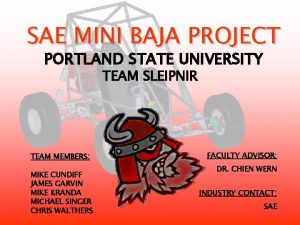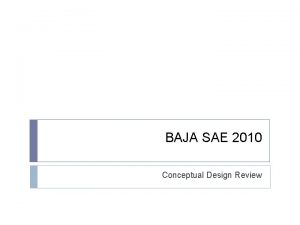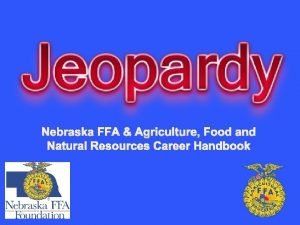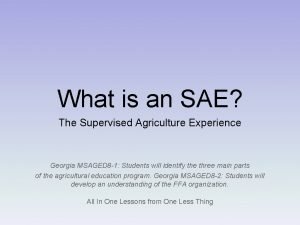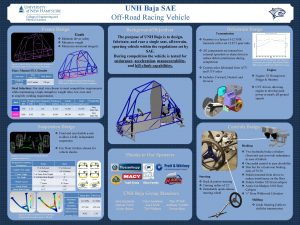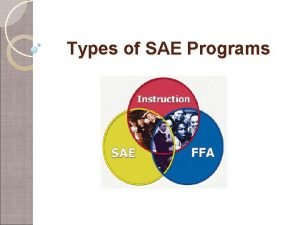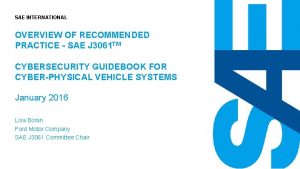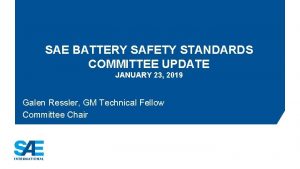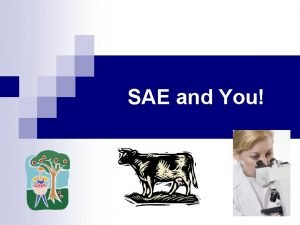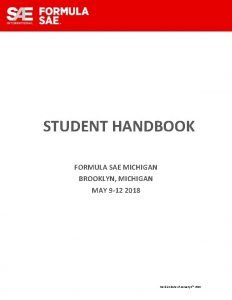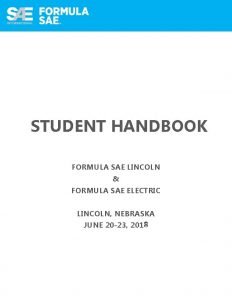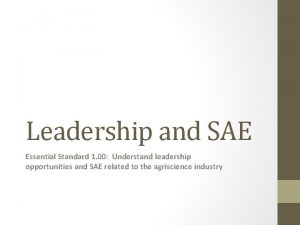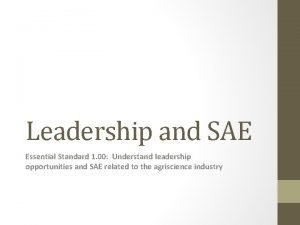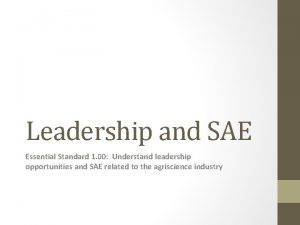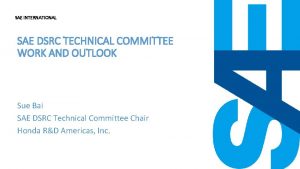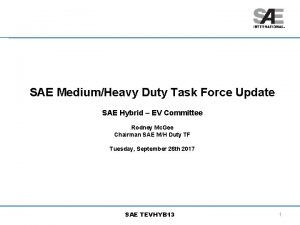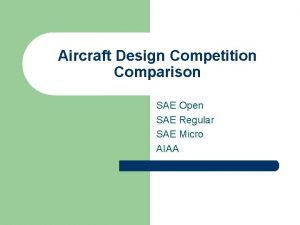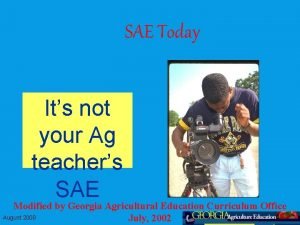Leadership and SAE Essential Standard 1 00 Understand



























































- Slides: 59

Leadership and SAE Essential Standard 1. 00: Understand leadership opportunities and SAE related to the agriscience industry

Objective 1. 01 • Understand the history, opportunities and structure of organizations related to the agriscience industry.

History of the National FFA Organization • 1917 Smith-Hughes Act • established funding • vocational agriculture in high school • Named after a senator in Georgia • 1920’s – Virginia was the first state to have Futures Farmers clubs • Boys only • North Carolina had a club called the “Young Tar Heel Farmers” • Chartered their FFA in 1929!!

History of the National FFA Organization • 1928 – FFA became a National Organization • A network of teachers guided the establishment of FFA • Effort to establish a club for boys with similar farm interests • The 1 st convention was held in the Hotel Baltimore in Kansas City, Missouri • The first dues were 10 cents (Current Chapter dues? ? ? ) • The 6 th National Convention

History of the National FFA Organization • 1928 – FFA became a National Organization • Henry C. Groseclose- known as the Father of the FFA for starting the FFV.

History of the National FFA Organization • 1930 – FFA Creed was written by Erwin Milton (E. M. ) Tiffany • A professor at the Department of Agriculture at the University of Wisconsin. • Wrote the creed when he was working on a display for the 1 st FFA Convention • Adopted at the 3 rd National Convention • Revised in 1965 and 1990 (63 rd) • Each paragraph begins with “I believe…”

History of the National FFA Organization • 1930 – FFA Creed was written by Erwin Milton (E. M. ) Tiffany • It is a basic statement of beliefs that helps members understand the importance of FFA • Expresses belief in work ethic, fairness, patriotism, and tradition that all members share. • New Ag. Ed. Students are required to learn it and recite it prior to being awarded the 1 st Degree of FFA membership: the Greenhand Degree

Memorizing the FFA Creed Your Mission: is to memorize and recite the FFA Creed. You must get all the words correct- or mostly correct- to receive credit. I will prompt you in class if you need some help. Part of your grade is also listening to your classmates recite theses items. This is your 1 st step in becoming a better leader and is a vital part of recognizing the history of the FFA. If you recite the FFA Creed by: __________ You will receive your Greenhand degree at our Chapter Banquet. 1 st Paragraph due: _________ 2 nd Paragraph due: _________ 3 rd Paragraph due: _________ 4 th Paragraph due: _________ 5 th Paragraph due: _________

Memorizing the FFA Creed • What if I get behind? – for each day you are behind in saying the creed you will lose 10 points. If you are absent the day we say a particular paragraph be prepared to say it the day you get back. • What if I have trouble memorizing? – Even it you have some trouble memorizing items, you are still responsible for the assignment. I will NOT accept written assignments instead. This will be worked out with students individually. • What if I am deathly afraid of speaking in front of the class? – Memorizing and reciting these items will help to break that fear. Speaking in front of the class is a very important skill and an important to becoming a more active FFA Member. You may stay after school – if you let me know- and say these items to me then. I would, however, encourage you to try to do them on the assigned day in class. By 4 th pd you will forget!!!

History of the National FFA Organization • 1935 – NFA was formed (New Farmers of America) • African American male students studying agriculture • Official colors were Black and Gold • Found mainly in southern states North Carolina State NFA Officers

History of the National FFA Organization • 1950 – Public Law 740 • FFA became one of a few student organizations to receive a Federal Charter from Congress • Law stating that each school teaching agriculture must have an FFA program • Created the 3 integral components to an Agriculture Education Program. • Classroom • Lab • SAE (Supervised Agriculture Experience)

History of the National FFA Organization • 1965 – FFA and NFA merged • 1969 – Girls allowed in FFA for the first time • Prior to 1969, there were girls in the FFA, however they used only their 1 st initial and last name (ex. L. Gardner) to register with FFA. • 1953: Industrial High FFA • 1970 – National FFA Alumni was founded • Founded for supporters of the FFA, not necessarily former FFA members

History of the National FFA Organization • 1988 – Name change • Future Farmers of America to National FFA Organization • Reflects the growing diversity in the agriculture industry • 2012 – National Convention completes 7 year run in Indianapolis • Returns to Louisville, Kentucky in 2013 for 3 years

Timeline Assignment Directions: Your assignment is to form a timeline of at least 10 important dates within the history of FFA and agriculture education. Your timeline should NOT contain text or written statements. The timeline you make should include a few letters, symbols, and numbers but keep the written text to a minimum. In addition: • Have pictures or drawings representing the FFA events • Fit the entire page • Colorful • Neat and Organized • Have a title and your name on top right corner

FFA Mission FFA makes a positive difference in the lives of students by developing their potential for premier leadership, personal growth and career success through agricultural education. • Develops premier leadership, personal growth and career success • Promotes teamwork, cooperation, and citizenship • SAE is the component used to help students learn to keep records, perform practical job skills, and gain opportunity for work and exploratory experience in Agriscience.

Opportunities within the FFA • Career Development Events (CDE’s) • Competitive Events - benefits • Most events progress from the local (chapter) to the federation, regional, state and national level. • Develops technical and leadership skills as well as confidence. • Recognition is received and prize money is often received for 1 st place state finish.

Opportunities within the FFA • Career Development Events (CDE’s) • Animal Science Competitive Events - examples • Dairy Evaluation • grade and evaluate dairy cattle • Poultry Evaluation • grade and evaluate chickens and chicken products • Livestock Judging • grade and evaluate beef cattle, sheep, swine and goats • Horse Judging • evaluate several classes of horses and present oral reasons

Opportunities within the FFA • Career Development Events (CDE’s) • Plant Science Competitive Events - examples • Introduction to Horticulture • knowledge of horticulture and plant identification • Nursery/Landscape • knowledge of the nursery and landscape industry and plant identification • Floriculture • knowledge of floral arrangement , horticulture and plant identification • Forestry • identification of trees and forestry tools as well as measurement of trees

Opportunities within the FFA • Career Development Events (CDE’s) • Leadership Competitive Events - examples • Creed speaking • recitation of the FFA creed. • Prepared Public Speaking • prepare and present a 6 -8 minute speech on an agriculturally related topic of your choice • Extemporaneous Public Speaking • present a 4 -6 minute speech on a topic given to you with 30 minutes preparation time • Parliamentary Procedure • present a mock business meeting • solve business problems and knowledge of business principles

Opportunities within the FFA • Career Development Events (CDE’s) • Agriculture Business Competitive Events - examples • Job Interview • performance of a mock interview for an agriculturally related job • Agricultural Sales • knowledge of sales and marketing • Farm Business Management • solve business problems and knowledge of business principles

Opportunities within the FFA • Career Development Events (CDE’s) • Agriculture Mechanical Competitive Events - examples • Agricultural Tools and Materials • knowledge and identification of tools • Agricultural mechanics • knowledge of agricultural mechanics as well as performance of specific mechanical skills

Agricultural Organizations related to the Agriscience Industry • Goals • Allow professionals the opportunity to network, learn, and communicate • Provide trade shows and journals • update members on new methods, products, and technology • Uses membership dues • • commodity advertisement trade journals educational programs scholarships for members WHAT ORGANIZATIONS CAN YOU THINK OF? ? ARE YOU A MEMBER OF ONE? ARE YOUR PARENTS? GRANDPARENTS? ? ?

Agricultural Organizations related to the Agriscience Industry • Types (examples) • Commodity related • Corn Growers Association (NCGA) • to create and increase opportunities for corn growers • North Carolina Pork Producers Council (NPPC) • promotes and educates a socially responsible and profitable NC pork industry

Agricultural Organizations related to the Agriscience Industry • Types (examples) • North Carolina Nursery and Landscape Association (NCNLA) • flexible, knowledgeable, responsive, environmentally- conscious organization • provides the nursery and landscape industries with leadership, technological and business advancement opportunities and information services • American Quarter Horse Association (AQHA) • world’s largest breed registry and membership organization • North Carolina Christmas Tree Association (NCCTA) • promotes “real” Christmas trees through marketing and education

Agricultural Organizations related to the Agriscience Industry • Other Types (examples) • NC Farm Bureau • unified voice in agricultural issues • offers insurance • provides scholarships and educational opportunities for youth • Carolina Farm Stewardship Assoc. (CFSA) • farm driven, membership based, non-profit, that helps people in the Carolinas grow and eat local, organic foods…… • Grange • is a family–oriented organization • serves its members through a variety of programs and promotes agriculture as an essential industry for our economy • FFA Alumni • open to those who wishes to support students in agricultural education

Organization Assignment Directions: You will research an agriculture organization that we talked about in class, and one that we have not gone over. Answer the following questions: 1. 2. 3. 4. 5. 6. What is their mission statement? What group or groups of people do they serve? Is it a state or national organization? What careers are available in the organization? Have you or your family been involved or directly benefited from this organization? Add a picture of their logo. Write the answers on a sheet of paper and turn into the INBOX Other examples: Cattlemen’s Assoc. , etc.

Objective 1. 02 • Understand effective leadership and communication skills.

Leadership Development in FFA 1. Purpose • Develops confidence, character and citizenship • Builds cooperative attitudes that help students work with others • Encourages the improvement of scholarship

Leadership Development in FFA 2. Ways and Means • Develop an appreciation of FFA traditions • Colors- • Program of Activities (POA) • calendar of activities that provides fun opportunities for members, creates a better chapter and provides service to the local community

Leadership Development in FFA 2. Ways and Means continued • Symbols and their meaning: 1. Eagle • National Scope of FFA 2. Plow • Labor and tillage of the soil 3. Owl • Knowledge and wisdom 4. Rising Sun • Progressive nature of agriculture • Need for cooperative effort to reach common goals 5. Ear of corn • Unity • FFA is a national organization with members from across the U. S. and Puerto Rico 6. Lettering “Agricultural Education” and “FFA” • signifies the combination of learning and leadership

Leadership Development in FFA 2. Ways and Means continued: • The FFA Motto:

Leadership Development in FFA 2. Ways and Means continued • Serving in leadership roles as an FFA Officer 1. President (rising sun) • presides over meetings 2. Vice president (plow) • coordinates all committee work 3. Secretary (ear of corn) • keeps records of all meetings 4. Treasurer (bust of Washington) • keeps financial records 5. Reporter (flag) • public relations 6. Sentinel (hand clasp and shield of friendship) • welcomes guests and visitors

Leadership Development in FFA 2. Ways and Means continued • Other opportunities to develop leadership in FFA • Leaderships schools, camps and conferences (WLC) • Committee involvement (Community service committee) • State and National Conventions • Raleigh, North Carolina in June • Louisville, Kentucky in October • Competitive events

Parliamentary Procedure

Conducting Business Meetings (Agenda) • Agenda • Call to order by the President • Opening ceremony in FFA meetings • Minutes of the previous meeting • read by the Secretary • approved by the body in accordance to organizational by-laws and parliamentary procedure • reminds members of what occurred at the last meeting • Treasurer reports • Report on Chapter Program of Activities (POA) • presented by officers and committee chairperson • Old Business • New Business • presented by members in the form of motions • Adjournment and closing ceremony • occurs by either passing a motion or by consensus of the body

Conducting Business Meetings (Agenda) • Purpose for an agenda • The agenda keeps the meeting moving forward • The agenda forms the framework for the development of a good meeting

General Principles of Parliamentary Procedure 1. Extends courtesy to everyone • Members must be recognized to speak • except in cases of emergency or to enforce parliamentary law • Members ask the president for recognition to speak • standing and saying ” Madame/Mr. President” 2. Focuses on one thing at a time • only one motion on the floor at a time • a main motion is presented by saying “I move to/that…”

General Principles of Parliamentary Procedure 3. Observes the rule of the majority • Only main motions that have been seconded can be discussed • Most motions require a simple majority to pass • Action only after the passing of a motion 4. Ensures the rights of the minority • Everyone has the right to voice their opinion during discussion of a motion regardless of which side they may be on • Therefore, a motion to stop discussion requires a 2/3 vote to pass • 20 out of 30 would have to vote to end discussion

Main Motion • Introduce new business 1. Address the presiding officer 2. Receive recognition to speak 3. State the motion • “I move that our FFA chapter conduct a community service project. ” 4. 5. 6. 7. • • Someone seconds the motion Discussed by the group Vote Chair announces result of vote Requires a second Debatable Amendable Majority vote required

Amendment • Alter or change a motion • adding • striking out • Substituting • • Requires a second Debatable Amendable Majority vote required

Refer to a Committee • To put the motion in the hands of a small group • “I move to refer this motion to a committee of three people appointed by the chair, who will report back at the next regular meeting” • • Requires a second Debatable Amendable Majority vote required

Previous Question • Introduce new business • “I move the Previous Question. ” • • Requires a second Not Debatable Not Amendable 2/3 Majority vote required

Suspend the Rules • Allow the chapter to act in a way that would be against the rules of parliamentary law. • “I move to suspend the rules and waive the reading of the minutes. ” • • Requires a second Not Debatable Not Amendable 2/3 Majority vote required

Point of Order • Enforces the rules of parliamentary law. • “I rise to a Point of Order. ” • • No second required Not Debatable Not Amendable No vote taken

Adjourn • Ends the meeting • “I move to adjourn. ” • • Second required Not Debatable Not Amendable Majority vote required

Voting • Common methods 1. Voice vote • by saying “aye” or “no” 2. Rising vote • Standing • show of hands 3. Secret ballot • written vote 4. Roll call • each member speaking their vote when the secretary calls their name

Gavel • Taps are used to signal members of action they should take or to signal the completion of a parliamentary action • One tap • follows announcement of adjournment • follows the completion of a business item • to be seated • Two taps • signal the official start of the meeting and calls the meeting to order • Three taps • are used to signal all members to stand • members are to rise in unison at the third tap of the gavel

Public Speaking • Oral communication skills are one of the most important factors in determining career success • The FFA Creed • gives students the opportunity to develop basic public speaking skills • helps to develop confidence • Oral communication can be improved through practice (and more practice) • Practice improves the speaker stage presence • • Attitude Confidence Personality Ease before the audience Personal appearance Poise Posture

The FFA Creed • History • • Written by E. M. Tiffany Adopted at the 3 rd National FFA Convention in 1930 Revised in 1965 and 1990 Each of the 5 paragraphs begins with “I believe……” • Use • Basic statement of beliefs that helps members understand the importance of FFA • Expresses belief in work ethic, fairness, patriotism, and tradition that all members can share • Requirement for the first degree of FFA membership • Greenhand Degree

Objective 1. 03 • Understand the importance of SAE to work-based learning.

SAE – What is it? 1. An individualized project • Supervised Agricultural Experience • Conducted outside of the regularly scheduled school day 2. Makes up the third part in a total agricultural education program • Classroom /laboratory instruction • FFA • SAE 3. SAE is for every student • A percent of your course grade

Purpose of SAE • • • Opportunities to explore a variety of subjects Educational and practical experience in a specialized area Opportunities for earning while learning Teaches accurate computerized or written records Win FFA awards • FFA proficiency awards

Types of SAE • Exploratory • Short duration usually • Students become more literate in agriculture • Develop awareness of agricultural careers • Examples: • • • Observing and/or assisting a veterinarian Interviewing a landscape contractor Shadowing a greenhouse employee Observing/assisting a welder Attending a career day/fair

Types of SAE • Entrepreneurship • Ownership or part-ownership • assume financial risk • Skills necessary to become established in one’s own business • Types of Entrepreneurship • Production SAE • Raise and sell an agricultural commodity for profit • Examples: produce vegetables, grow Christmas trees, raise livestock, dogs, or horses, grow field or nursery crops. • Agribusiness SAE • Students own and operate an agricultural related business • Examples: lawn maintenance or landscaping business, crop scouting service, pet sitting service, feed sales, computer service for farms, horse riding lessons

Types of SAE • Placement • Students obtain a job with an employer • often with the help of their instructor • Typically paid an hourly wage • Examples: • Placement in Production • on a farm • greenhouse • nursery or other production facility • Placement in Agribusiness • • work at a veterinary clinic florist feed store landscaping business

Types of SAE • Improvement • Activities are done to improve the appearance, convenience, efficiency, safety or value of a home, farm or other facility. • No wages earned • No ownership necessary • Examples: • • • landscape parent or grandparent’s home building a fence building a storage shed growing herbs or vegetables in containers on a porch or patio assist with landscape maintenance at an apartment complex

Types of SAE • Analytical • Students choose an agricultural problem not easily tested by experimentation • Gather and evaluate data • Non-experimental • Examples: • Develop marketing plan for poinsettia crop • Research and present project on effects of temperature change on corn yields in South America

Types of SAE • Experimental • Students conduct and an agriculturally related experiment • Scientific method • Examples: • Compare the effects of various rates of nitrogen on poinsettias • Compare the effects of various feeds on average daily gain in lambs • Can be used to compete in the State Agriscience Fair.

Types of SAE • Supplementary • Activities are short-term activities with little or no planning involved • Skill specific, non- wage earning • Examples: • • • learning to prune peach or apple trees changing hydraulic fluid in a tractor mowing a baseball infield or putting green trimming sheep feet bottle feeding dairy calves
 To understand recursion you must understand recursion
To understand recursion you must understand recursion Understand professional management and leadership
Understand professional management and leadership Characteristics of lipids
Characteristics of lipids Commonly damaged areas of a vehicle during hoisting
Commonly damaged areas of a vehicle during hoisting Transactional leadership vs transformational leadership
Transactional leadership vs transformational leadership What is adaptive leadership theory
What is adaptive leadership theory Capable but cautious performer
Capable but cautious performer Standard error and standard deviation
Standard error and standard deviation Differences between home language and standard language
Differences between home language and standard language Meaning of standard costing
Meaning of standard costing Dskp bahagian pembangunan kurikulum
Dskp bahagian pembangunan kurikulum Sae baja rack and pinon
Sae baja rack and pinon Rack and pinion baja sae
Rack and pinion baja sae Rack and pinion gear sae baja cockpit
Rack and pinion gear sae baja cockpit Blue and gold basics sae programs
Blue and gold basics sae programs History help us understand people and societies
History help us understand people and societies Understand quran and salah the easy way
Understand quran and salah the easy way Understand quran and salah the easy way pdf
Understand quran and salah the easy way pdf Role of quantitative research
Role of quantitative research Bc and ad on a timeline
Bc and ad on a timeline Understand quran and salah the easy way
Understand quran and salah the easy way Understand quran and salah
Understand quran and salah Understandquran
Understandquran Www.understandquran.com in english
Www.understandquran.com in english How to understand and apply the old testament
How to understand and apply the old testament What does it mean to be a critical reader
What does it mean to be a critical reader Quran for beginners lesson 4
Quran for beginners lesson 4 Lesson 3 understand rational and irrational numbers
Lesson 3 understand rational and irrational numbers 7 rational or irrational
7 rational or irrational And understand
And understand Misleading graph
Misleading graph What is an sae
What is an sae Sae unh
Sae unh Entrepreneurship sae examples
Entrepreneurship sae examples Research/experimentation sae examples
Research/experimentation sae examples Sae my techzone
Sae my techzone Sae epc
Sae epc Sae j2579
Sae j2579 Sae techzone
Sae techzone Sae reconciliation steps
Sae reconciliation steps Tim weisenberger
Tim weisenberger Cv sae
Cv sae Sae j3061 software
Sae j3061 software Sae j 2464
Sae j 2464 Arp 4761a
Arp 4761a Sae definition ffa
Sae definition ffa Bulk current injection testing
Bulk current injection testing All obd ii vehicles use what type of read-only memory?
All obd ii vehicles use what type of read-only memory? Sae lse
Sae lse Sae s18
Sae s18 Problem statement formula
Problem statement formula Entrepreneur sae
Entrepreneur sae Fsae michigan may
Fsae michigan may Homedepot
Homedepot Sae j3068
Sae j3068 Formula sae international
Formula sae international Excavator control levers
Excavator control levers Michael niehoff
Michael niehoff Essnet sae
Essnet sae Sae government industry meeting 2019
Sae government industry meeting 2019












